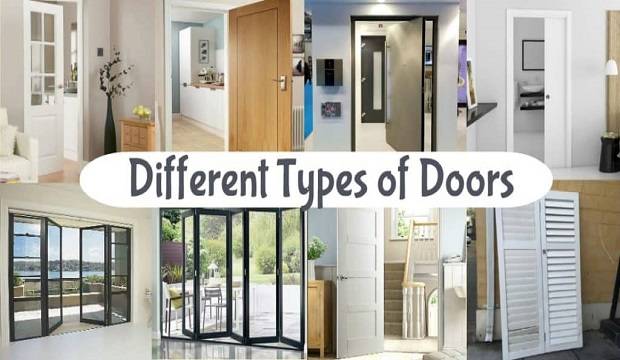Types of doors
1. Ledged and battened doors: These are the simplest type of doors. They consist of battens (each 100 to 150 mm wide and 16 to 32mm thick) which are screwed to three horizontal members called ledges. The middle and bottom ledges are wider than the top ledge which is usually 100mm wide while the middle and bottom ledges are 150mm wide.
2. Ledged, battened and braced doors: These doors are similar to the ledged and battened type of doors except that they consist of ledges and battens which are strengthened with the help of diagonal members, known as braces. These braces act like struts between the ledges and increase the strength and rigidity of the door. The inclination of the braces should be kept towards the side of the shutter.

3. Framed, battened, and braced doors: These are better and stronger types of doors. They consist of two styles, three ralls, and braces, forming the framework of each leaf (shutter) to which the battens are fixed. The battens should butt into the rebate in the top and bottom rails. Such shutters are hung to the frame by means of butt hinges.
4. Framed and paneled doors: These are the most common type of doors. They are made in different designs but their principle for construction as the same as in other doors. They consist of a framework of styles, rails, and muntins or mullions of the same thickness. The space between them is filled with panels.
Types of Doors in Building |HINDI| Building Construction & Material
Vertical styles are continuous from top to bottom and rails are joined to the styles. On the Inside of the styles and rails, grooves are made to receive the panels which may be of raised or flush type.
5. Panelled and glazed doors: The construction of this type of door is similar to a framed and panelled door but in such doors glass panes are fixed. In these doors instead of providing wooden panels in their top portions, sash bars to receive the glass panes are used. The size of the rebate is generally 16mm X 6mm. Each glass pane is secured in position by small nails and is bedded with the help of lime putty.
6. Flush doors: These doors are made with plywood and give a better appearance. They are solid and semi-solid doors and are constructed and finished in many ways. The sizes of flush doors vary according to the requirements. But in general, the size of commonly used flush doors varies from 0.9m X 1.90m to 1.2m X 2.1m. These doors do not catch dust and are easy to clean. With the production of plywood in large quantities, flush doors are becoming more and more popular these days.
7. Louvered doors: These doors are similar to glazed and panelled doors. But in these doors, the spaces between the rails and styles are filled with a series of wooden members called louvers. The louvers are fixed into the styles or made movable. In order for these doors may be effective and economical, louvers are fixed at an angle of 45°. These doors allow free passage of light, air and also secure privacy and safety. But they collect dust easily and are difficult to clean.
8. Miscellaneous doors:
1. Revolving doors: These doors consist of four shutters, arranged diagonally, revolving on a common vertical axis. Panelled, glazed or both types of shutters may be used for these doors. They allow entrance on one side and exist on the other side.
2. Side sliding doors: These doors consist of single or double steel or wooden shutters. They slide into the pockets provided into the masonry wall built.
3. Collapsible doors: These doors consist of a framework of rolled steel sections and are provided with rollers at the bottom which roll on rails. These doors are rolled when they are to be opened or collapsed. Flat iron pieces are used crosswise and are fixed to vertical flat iron pieces at 120 to 150mm center to center so as to form parallelograms.
4. Steel rolling door: These doors are generally made up of thin corrugated steel plates (or sheets) that roll up on a roller drum. The shutter slides and grooves in the side walls. The shutter is usually counterbalanced by springs so that it can be easily raised or lowered by hands.
5. Wire gauged doors: These doors are normally hung on the same chaukhat(frame) on which other door shutters are provided. The thickness of the frame is increased suitably to cut the rebate for the wire-gauged shutters.
Read This